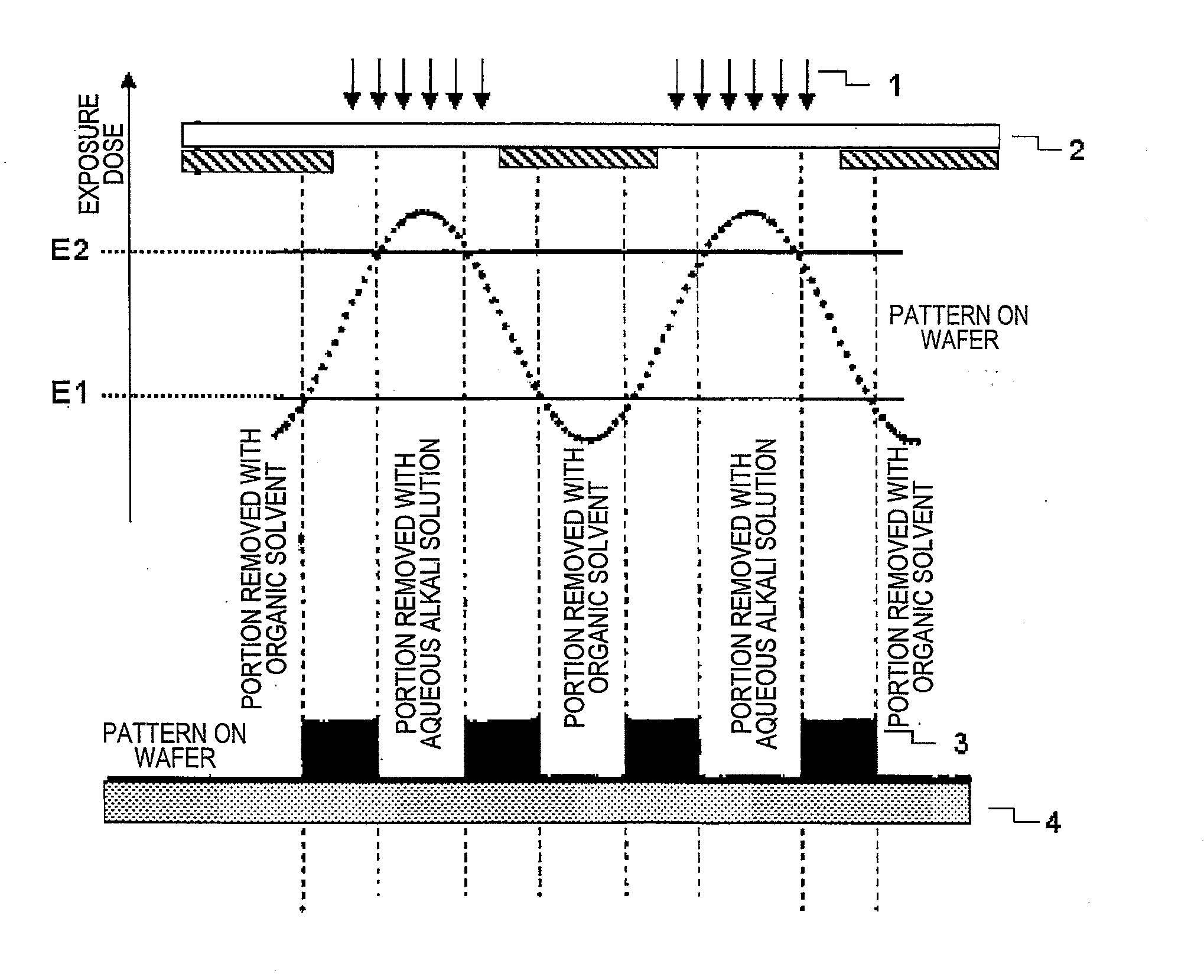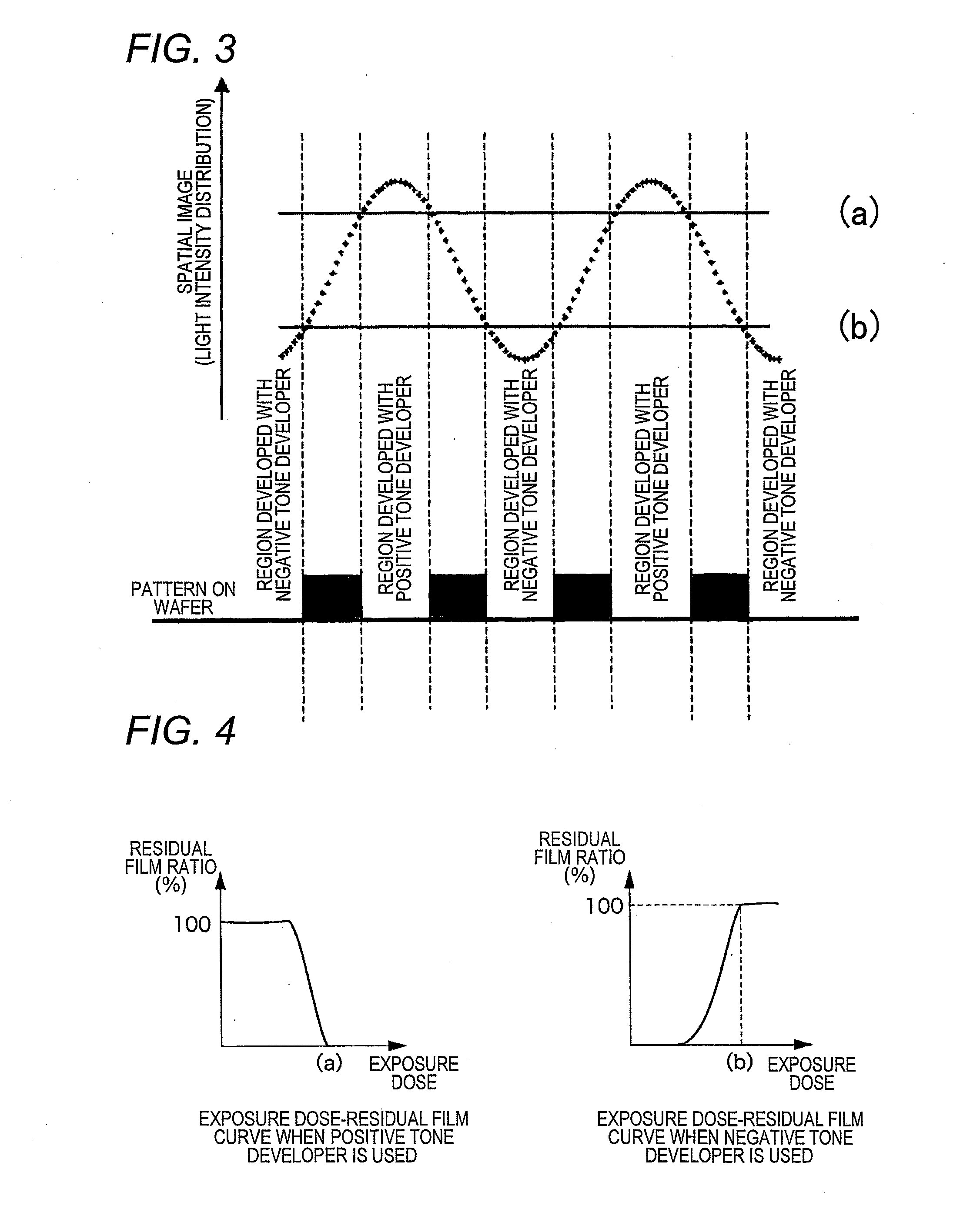Pattern forming method, and resist composition, developer and rinsing solution used in the pattern forming method
a technology of resist composition and pattern forming method, which is applied in the direction of photosensitive materials, instruments, photomechanical equipment, etc., can solve the problems of reducing optical contrast and unable to obtain sufficient exposure margin or depth of focus, and achieves high dimensional uniformity and reduces roughness of line edges
- Summary
- Abstract
- Description
- Claims
- Application Information
AI Technical Summary
Benefits of technology
Problems solved by technology
Method used
Image
Examples
synthesis example 1
Synthesis of Resin (A1)
[0576]Under a nitrogen stream, 8.4 g of methyl isobutyl ketone was charged into a three-neck flask and heated at 80° C. Thereto, a solution obtained by dissolving 9.4 g of 2-(1-adamantyl)propan-2-yl methacrylate, 4.5 g of 3,5-dihydroxy-1-adamantyl methacrylate, 6.1 g of β-methacryloyloxy-γ-butyrolactone and azobisisobutyronitrile corresponding to 6 mol % based on the entire monomer amount, in 75.3 g of methyl isobutyl ketone was added dropwise over 6 hours. After the completion of dropwise addition, the reaction was further allowed to proceed at 80° C. for 2 hours. The resulting reaction solution was allowed to cool and then poured in 720 ml of heptane / 80 ml of ethyl acetate, and the powder precipitated was collected by filtration and dried, as a result, 18.3 g of Resin (A1) was obtained. The weight average molecular weight of the obtained resin was 7,000 and the dispersity (Mw / Mn) was 1.80.
synthesis example 2
Synthesis of Resin (A2)
[0577]Under a nitrogen stream, 8.4 g of methyl isobutyl ketone was charged into a three-neck flask and heated at 80° C. Thereto, a solution obtained by dissolving 9.4 g of 2-(1-adamantyl)propan-2-yl methacrylate, 4.5 g of 3,5-dihydroxy-1-adamantyl methacrylate, 6.1 g of β-methacryloyloxy-γ-butyrolactone and azobisisobutyronitrile corresponding to 7 mol % based on the entire monomer amount, in 75.3 g of methyl isobutyl ketone was added dropwise over 6 hours. After the completion of dropwise addition, the reaction was further allowed to proceed at 80° C. for 2 hours. The resulting reaction solution was allowed to cool and then poured in 680 ml of heptane / 120 ml of ethyl acetate, and the powder precipitated was collected by filtration and dried, as a result, 17.5 g of Resin (A2) was obtained. The weight average molecular weight of the obtained resin was 5,800 and the dispersity (Mw / Mn) was 1.53.
synthesis example 3
Synthesis of Resin (A3)
[0578]Under a nitrogen stream, 19.4 g of methyl isobutyl ketone was charged into a three-neck flask and heated at 80° C. Thereto, a solution obtained by dissolving 9.4 g of 2-(1-adamantyl)propan-2-yl methacrylate, 4.5 g of 3,5-dihydroxy-1-adamantyl methacrylate, 6.1 g of β-methacryloyloxy-γ-butyrolactone and azobisisobutyronitrile corresponding to 12 mol % based on the entire monomer amount, in 65.3 g of methyl isobutyl ketone was added dropwise over 8 hours. After the completion of dropwise addition, the reaction was further allowed to proceed at 80° C. for 2 hours. The resulting reaction solution was allowed to cool and then poured in 720 ml of heptane / 80 ml of ethyl acetate, and the powder precipitated was collected by filtration and dried, as a result, 15.5 g of Resin (A3) was obtained. The weight average molecular weight of the obtained resin was 2,800 and the dispersity (Mw / Mn) was 1.26.
PUM
 Login to View More
Login to View More Abstract
Description
Claims
Application Information
 Login to View More
Login to View More - R&D
- Intellectual Property
- Life Sciences
- Materials
- Tech Scout
- Unparalleled Data Quality
- Higher Quality Content
- 60% Fewer Hallucinations
Browse by: Latest US Patents, China's latest patents, Technical Efficacy Thesaurus, Application Domain, Technology Topic, Popular Technical Reports.
© 2025 PatSnap. All rights reserved.Legal|Privacy policy|Modern Slavery Act Transparency Statement|Sitemap|About US| Contact US: help@patsnap.com



